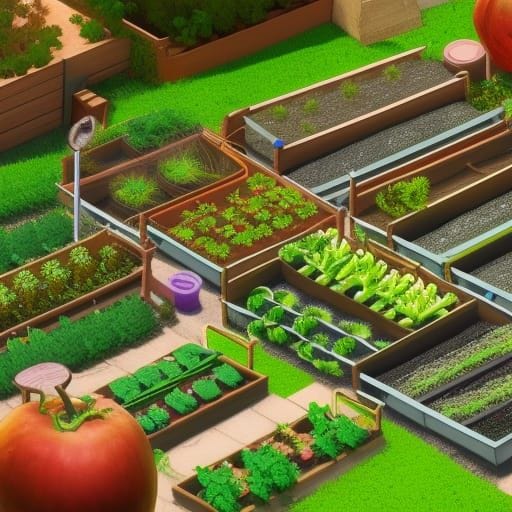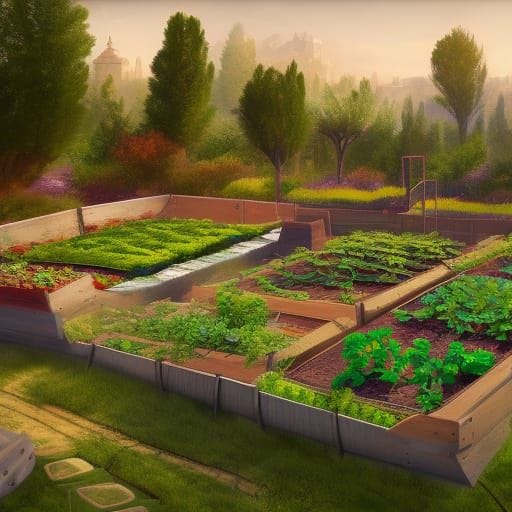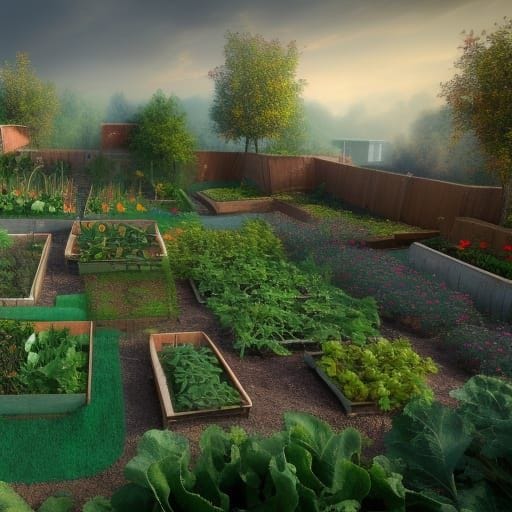School gardens are not just a nice addition to the schoolyard, they are a powerful learning tool that can benefit students in many ways. In this article, I will make the case that schools should have a vegetable garden and teach children about growing food, based on the evidence from research and practice.

School gardens help children learn better
One of the main benefits of school gardens is that they enhance children’s academic performance and attitudes towards learning. Gardening is a hands-on, experiential, and interdisciplinary activity that can be integrated into various subjects, such as science, math, language arts, social studies, and art. Gardening can also foster critical thinking, problem-solving, creativity, and collaboration skills.
Studies have shown that students who participate in school gardening programs score higher on standardized tests, have better grades, and show more interest and engagement in learning1. For example, a study in California found that students who were involved in a school garden program had significantly higher science achievement scores than those who were not2. Another study in Texas found that students who received garden-based nutrition education had higher math and reading scores than those who did not3.
School gardens can also support children’s social and emotional development. Gardening can reduce stress, anxiety, and aggression, and increase self-esteem, confidence, and empathy1. Gardening can also promote positive behavior and attitudes among students, such as cooperation, responsibility, respect, and leadership4. For instance, a study in New York found that students who participated in a school garden program had fewer disciplinary referrals and improved attendance than those who did not5.

School gardens connect children with nature and food
Another benefit of school gardens is that they help children develop a connection with nature and food. Many children today live in urban environments and have limited exposure to natural settings and the source of their food. School gardens can provide an opportunity for children to interact with living organisms, observe natural processes, and appreciate the diversity and beauty of nature6.
School gardens can also increase children’s awareness of the seasonal nature and the variety of food. By growing their own vegetables, children can learn about the life cycles of plants, the nutritional value of different crops, and the environmental impact of food production7. School gardens can also encourage children to try new foods, develop healthy eating habits, and appreciate the cultural aspects of food.
Studies have shown that children who garden have an increased preference for, intake of, and openness to fruits and vegetables. For example, a study in Colorado found that students who participated in a school garden program increased their vegetable consumption by 2.5 servings per day. Another study in Iowa found that students who grew their own vegetables were more willing to taste them than those who did not.

School gardens strengthen ties between school and community
A third benefit of school gardens is that they foster a sense of community among school stakeholders and local partners. School gardening programs can involve parents, teachers, students, administrators, food service staff, volunteers, and community organizations in various ways. For example, parents can help with fundraising, planting, harvesting, or cooking; teachers can use the garden as a teaching tool or a professional development opportunity; students can take ownership of the garden or share their produce with others; administrators can support the garden program or advocate for its sustainability; food service staff can incorporate garden produce into school meals or snacks; volunteers can provide expertise or labor; and community organizations can offer resources or partnerships.
School gardens can also enhance the image and reputation of the school within the community. School gardens can showcase the school’s commitment to environmental stewardship, health promotion, and academic excellence. School gardens can also attract positive media attention and public recognition. For example, some schools have received awards or grants for their garden programs from local or national entities.

How to start a school garden
Starting a school garden may seem daunting at first, but it is not impossible. There are many resources and examples available to guide schools through the process. The basic steps to building a successful school garden program include:
- Gathering support: The first step is to identify the need and interest for a school garden among school stakeholders and local partners. A survey or a meeting can be used to gauge the level of support and involvement from different groups. A vision statement or a mission statement can be developed to articulate the goals and benefits of the school garden.
- Forming a garden committee: The next step is to form a garden committee that will oversee the planning, implementation, and evaluation of the school garden program. The committee should include representatives from different groups involved in the school garden, such as parents, teachers, students, administrators, food service staff, volunteers, and community organizations. The committee should meet regularly to discuss the progress and challenges of the school garden program.
- Determining garden program goals: The third step is to determine the specific goals and objectives of the school garden program, based on the needs and interests of the school and the community. The goals and objectives should be SMART: Specific, Measurable, Achievable, Relevant, and Time-bound. The goals and objectives should also align with the school’s curriculum and standards.
- Designing the garden: The fourth step is to design the garden layout, features, and elements, based on the available space, resources, and budget. The garden design should consider the following factors: location, size, shape, orientation, soil, water, drainage, irrigation, fencing, pathways, beds, plants, structures, tools, equipment, signage, and aesthetics. The garden design should also reflect the goals and objectives of the school garden program.
- Identifying needs and obtaining resources: The fifth step is to identify the needs and obtain the resources for the school garden program. The needs may include materials, supplies, funds, labor, expertise, training, or permission. The resources may come from various sources, such as donations, grants, fundraisers, sponsors, partners, or volunteers. A budget and a timeline should be developed to track the expenses and income of the school garden program.
- Building and maintaining the garden: The sixth step is to build and maintain the garden according to the design plan. This step involves preparing the site, installing the features and elements, planting the crops, watering the plants, weeding the beds, harvesting the produce, composting the waste, and repairing or replacing any damaged or broken items. This step also involves engaging students in various gardening activities and lessons throughout the year.
- Evaluating and celebrating the garden: The final step is to evaluate and celebrate the outcomes and impacts of the school garden program. This step involves collecting data and feedback from different sources, such as surveys, interviews, observations, tests, grades, or records. This step also involves analyzing and reporting the results and findings to different audiences, such as school stakeholders, local partners, or media outlets. This step also involves celebrating and acknowledging the achievements and contributions of everyone involved in the school garden program.
Conclusion
School gardens are more than just a nice addition to the schoolyard. They are a powerful learning tool that can benefit students in many ways. School gardens can help children learn better academically and emotionally; connect children with nature and food; and strengthen ties between school and community. School gardens can also provide an opportunity for schools to showcase their commitment to environmental stewardship, health promotion, and academic excellence.
Starting a school garden may seem daunting at first, but it is not impossible. There are many resources and examples available to guide schools through the process. By following some basic steps and involving different groups in the planning and implementation of the school garden program, schools can create a successful and sustainable school garden that can enrich their students’ lives for years to come.
References:
1: How to Start a School Garden: Your Complete Guide 2: The Effects of School Gardens on Students’ Science Knowledge 3: The Impact of Garden-Based Learning on Student Vegetable Consumption 4: The Benefits of School Gardens — Sustainable Food Center 5: The Impact of School Gardens on Academic Achievement 6: School Gardens: Can They Make Our Children Smarter? 7: Growing vegetables in school gardens — Royal Horticultural Society : School Gardens Enhance Academic Performance : The Benefits of School Gardens : Impact of a School-Based Cooking Curriculum for Fourth-Grade Students on Attitudes : Growing Healthy Kids through Farm-to-School Programs : Starting a School Garden Program: Overview — KidsGardening : Start A School Garden — Here’s How… | USDA
Learn more:
1. gse.harvard.edu2. sustainablefoodcenter.org3. sustainablefoodcenter.org4. learn.eartheasy.com5. schoolgardening.rhs.org.uk6. kidsgardening.org7. usda.gov8. learn.eartheasy.com9. sustainablefoodcenter.org10. schoolgardening.rhs.org.uk11. kidsgardening.org12. usda.gov13. gettyimages.com+12 more
